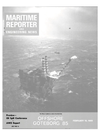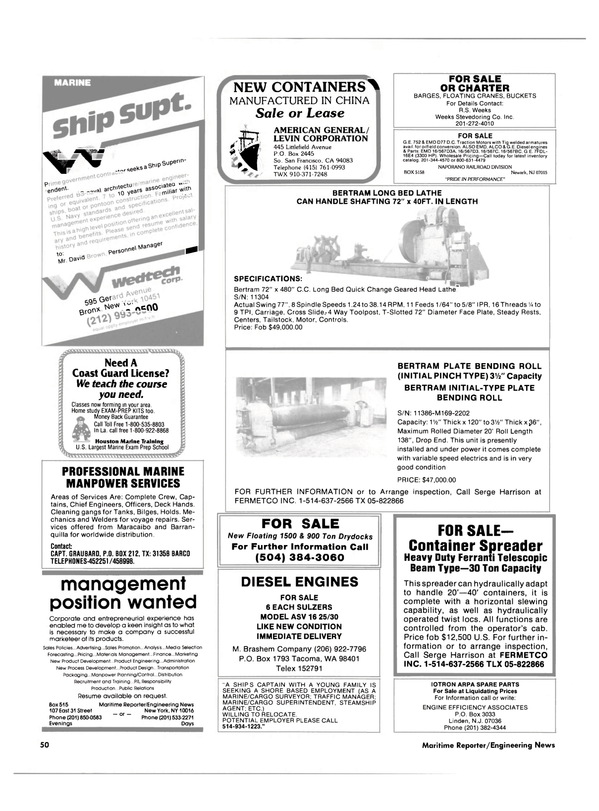
Worthington Offers Free Publication On Fire-Fighting Monitors
The tremendous increase in drilling and production platforms around the world has caused the petroleum industry to place new emphasis on protecting lives and equipment from the hazards of fire.
This need has caused equipment manufacturers to search for better pumps and fire monitors for optimum placement of water at platform fire locations.
In tests of the effects of pump pressures and fire nozzle shapes on water trajectories, a Worthington team compared various combinations of nozzles (with cone and parallel configurations), monitors, and pumps. A report on the result of these tests has recently been published in an issue of "Power & Fluids" (Vol. 10/No. 2) by Worthington Division, McGraw-Edison Company, of New Jersey.
The first part of the 20-page color publication is devoted to an article titled "Fire-fighting monitor research aids offshore oil field safety," by Anthony Lukes, London area sales manager of Worthington International Inc., and Victor Carrell, an engineer at Worthington- Simpson Ltd., England. The article points out that in the middle 1970s, when the petroleum industry began developing specialized craft for offshore fire-fighting duties, followed by radically different seagoing units such as the emergency support vessel (ESV) IOLAIR, built for British Petroleum, it became apparent at the preliminary design stage that there was a lack of firm and reliable data on which to base the design of fire-fighting equipment to meet their needs. For this reason, Worthington- Simpson and its associates decided to conduct tests with fullsize equipment to accurately define the state-of-the-art and to advance it if possible. These tests are said to have produced findings that promise more effective marine fire-fighting devices and may contribute to onshore technology as well.
The article, which is illustrated with photos, profile of rig layout, etc., lists the test objectives and discusses the designing of the test rig, test nozzles, pressure measurements, measuring jet trajectory, test procedure, total number of tests carried out, nozzle shapes, trajectories at different flow rates and pressures, pressure drops and velocity through the monitor, and conclusions drawn from the tests.
The last part of the "Power & Fluids" issue presents Part I of a paper by Igor Karassik, chief consulting engineer for Worthington, titled "Centrifugal pump application . . . the next milestone (VFD)." The paper discusses the advantages and benefits of variablefrequency drives (VFD), long-range developments, and conclusions.
The cover of the pamphlet features a striking photograph of the unusual vessel ESV IOLAIR, described as the world's largest fire engine, which can provide a number of emergency services for North Sea oil production platforms.
For a free copy of the above issue of "Power & Fluids" from Worthington, Circle 29 on Reader Service Card
Read Worthington Offers Free Publication On Fire-Fighting Monitors in Pdf, Flash or Html5 edition of February 15, 1985 Maritime Reporter
Other stories from February 15, 1985 issue
Content
- Imi-Tech Awarded $300,000 In Navy Research Contracts page: 4
- Two More U.S. Lines Containerships Delivered Early By Daewoo Yard page: 5
- Whitey Introduces New Severe Service Valve page: 5
- Loftus Succeeds Graham As Vice President-Sales For Moran Towing page: 6
- Coburn Appointed Area Manager For Sea-Land— Martin Named Port Manager page: 6
- Gulf Coast Trailing Dredge Under Construction At Twin City Shipyard page: 6
- Laviola And Adelman Named Corporate Vice Presidents At M. Rosenblatt & Son Firm page: 6
- Chaplin Appointed Vice President-Development For Bell Aerospace Textron page: 7
- Szczypinski Named Vice President Of Techmatics page: 7
- Folk Signs License Agreement With Renk For Reverse-Reduction Drives page: 8
- Mitsui Delivers Bulk Carrier To Kohoi Shipping Of Hong Kong page: 8
- W.A.I.T.! Alloy Identification Kits Introduced By Fenner page: 8
- Tracor Awarded $16-Million Contract For Automated Communications System page: 10
- St. Pe Succeeds Erb As President of Ingalls Shipbuilding Division page: 10
- FMC Offers Brochure On High-Capacity Centrifugal Pumps page: 11
- OFFSHORE GOTEBORG 85 page: 12
- FMC Offers Compact Turbine-Driven Centrifugal Boiler-Feed Pump page: 19
- Society Of Marine Consultants Reviews Arctic Oil Transportation page: 20
- Amor And Frayling Named Vice Presidents For Lister Diesels page: 20
- Navy Buys 11 More Ships For Ready Reserve Fleet At Cost Of $82.5 Million page: 21
- Peterson Yard Launches Another Rescue/Salvage Vessel For Navy page: 22
- MarAd Approves Sale Of Delta Line To U.S. Lines page: 22
- Boeing Sells Jetfoil To Canadian Company For Marine Research page: 22
- New York SNAME Meeting Hears Paper On Shipboard Computers page: 22
- Third Rowan Gorilla Drilling Rig Delivered By Marathon LeTourneau page: 28
- Morris Guralnick Firm Awarded Two Contracts For Conversion Designs page: 29
- Navy Awards NASSCO $14 Million For Overhaul Of Tank Landing Ship page: 29
- OIL SPILL CONFERENCE page: 30
- FAIRNESS, SIMPLICITY AND ECONOMIC GROWTH page: 37
- New Racal-Decca Problem-Solving Electronics Unveiled page: 41
- SweetWater RO Unit Selected For Antarctic Expedition By British page: 42
- Wartsila Delivers Combination Tanker xTavi' To Neste Oy page: 42
- Sea-Land Cranes Complete Trip From Japan To Port Of Tacoma page: 47
- General Thermodynamics Offers Free Literature On 300-A BMEP Balancer page: 48
- Worthington Offers Free Publication On Fire-Fighting Monitors page: 48
- Nelson Industries Introduces xBilge Boy' Oily Water Separator page: 51


